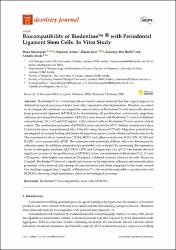| dc.contributor.author | Abuarqoub, Duaa A. | |
| dc.contributor.author | Aslam, Nazneen | |
| dc.contributor.author | Jafar, Hanan D. | |
| dc.contributor.author | Harfil, Zakariya Abu | |
| dc.contributor.author | Awidi, Abdalla S. | |
| dc.date.accessioned | 2020-12-21T08:28:34Z | |
| dc.date.available | 2020-12-21T08:28:34Z | |
| dc.date.issued | 2020 | en_US |
| dc.identifier.citation | Abuarqoub, D. A., Aslam, N., Jafar, H. D., Harfil, Z. A. ve Awidi, A. S. (2020). Biocompatibility of biodentine™ ® with periodontal ligament stem cells: In vitro study. Dentistry Journal, 8(1). https://dx.doi.org/10.3390/dj8010017 | en_US |
| dc.identifier.issn | 2304-6767 | |
| dc.identifier.uri | https://dx.doi.org/10.3390/dj8010017 | |
| dc.identifier.uri | https://hdl.handle.net/20.500.12511/6110 | |
| dc.description.abstract | Biodentine™ is a tricalcium silicate-based cement material that has a great impact on different biological processes of dental stem cells, compared to other biomaterials. Therefore, we aimed to investigate the optimum biocompatible concentration of Biodentine™ with stem cells derived from periodontal ligament (hPDLSCs) by determining cell proliferation, cytotoxicity, migration, adhesion and mineralization potential. hPDLSCs were treated with Biodentine™ extract at different concentrations; 20, 2, 0.2 and 0.02 mg/mL. Cells cultured without Biodentine™ were used as a blank control. The proliferation potential of hPDLSCs was evaluated by MTT viability analysis for 6 days. Cytotoxicity assay was performed after 3 days by using AnnexinV/7AAD. Migration potential was investigated by wound healing and transwell migration assays at both cellular and molecular levels. The expression levels of chemokines CXCR4, MCP-1 and adhesion molecules FGF-2, FN, VCAM and ICAM-1 were measured by qPCR. The communication potentials of these cells were determined by adhesion assay. In addition, mineralization potential was evaluated by measuring the expression levels of osteogenic markers; ALP, OCN, OPN and Collagen type1 by qPCR. Our results showed significant increase in the proliferation of hPDLSCs at low concentrations of Biodentine™ (2, 0.2 and 0.02 mg/mL) while higher concentration (20 mg/mL) exhibited cytotoxic effect on the cells. Moreover, 2 mg/mL Biodentine™ showed a significant increase in the migration, adhesion and mineralization potentials of the derived cells among all concentrations and when compared to the blank control. Our findings suggest that 2 mg/mL of Biodentine™ is the most biocompatible concentration with hPDLSCs, showing a high stimulatory effect on the biological processes. | en_US |
| dc.description.sponsorship | Cell Therapy Center-The University of Jordan | en_US |
| dc.language.iso | eng | en_US |
| dc.publisher | MDPI Multidisciplinary Digital Publishing Institute | en_US |
| dc.rights | info:eu-repo/semantics/openAccess | en_US |
| dc.rights | Attribution 4.0 International | * |
| dc.rights.uri | https://creativecommons.org/licenses/by/4.0/ | * |
| dc.subject | Biocompatibility | en_US |
| dc.subject | Biodentine™ | en_US |
| dc.subject | hPDLSCs | en_US |
| dc.subject | Stem Cells | en_US |
| dc.title | Biocompatibility of biodentine™ ® with periodontal ligament stem cells: In vitro study | en_US |
| dc.type | article | en_US |
| dc.relation.ispartof | Dentistry Journal | en_US |
| dc.department | İstanbul Medipol Üniversitesi, Diş Hekimliği Fakültesi | en_US |
| dc.identifier.volume | 8 | en_US |
| dc.identifier.issue | 1 | en_US |
| dc.relation.publicationcategory | Makale - Uluslararası Hakemli Dergi - Kurum Öğretim Elemanı | en_US |
| dc.identifier.doi | 10.3390/dj8010017 | en_US |
| dc.identifier.scopusquality | Q2 | en_US |



















